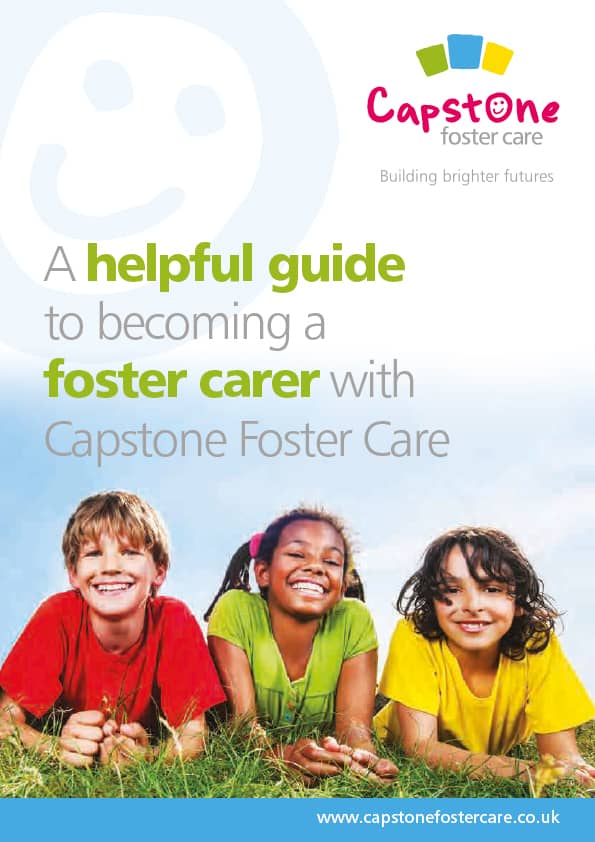


Fostering a disabled child
The role of an independent fostering agency
Can I choose who I foster?
How to foster
What are the benefits of fostering with an independent fostering agency?
What happens when a child is taken into care?
Fostering process: what happens on an initial home visit?
Can you foster if you have mental health issues?
Fostering with local authority vs independent agency
Interview: Life as a foster parent during the pandemic
Becoming A Foster Carer
Benefits of becoming a foster parent
What is a Care Leaver?
What is a Foster Carer?
What is Foster Care?
Do I become a Foster Carer?
Fostering Regulations
How much do Foster Parents get paid?
How to Foster a Child
How long does it take to become a Foster Carer?
How to foster – everything you ever wanted to know
Facts about Foster Care
What are the Foster Care requirements?
Foster Care Handbook
Foster Carer Job Description
Changing IFA - Transferring to Capstone
Fostering Definition
Foster Care Statistics
Fostering Assessment
Fostering Outcomes
Fostering Stories
Fostering Children UK
Children needing Fostering
8 reasons why a child may be taken into care
Fostering as a Career
Looked after Children
Top transferable job skills to become a foster carer
Fostering as a same sex couple
Fostering while renting
Can I foster if...?
Mythbusting the top 10 Foster Care Myths
Can I foster if I am disabled?
LGBT Fostering Mythbusting
Can I foster if I have pets?
Can I Foster A Child?
Can you Foster and Work?
Can you Foster with a Criminal Record
Fostering as a Single Parent
LGBT Family and Foster Care
Fostering across Cultures
Muslim Fostering
Christian Foster Care
Sikh
Empty Nest Syndrome and Foster Care
10 things you can do when your Children fly the nest
Can I Foster?
Fostering Babies - Myths
Focusing on Parent & Child Fostering
Fostering Siblings
Fostering Teenagers
Fostering Teenagers - Breaking down the Myths
Fostering Unaccompanied and Asylum Seeking Children
Mother and Baby Foster Placements
Private Fostering
Therapeutic Fostering - Multi-disciplinary Assessment Treatment & Therapy Service (MATTS)
Young Children Fostering Placements
Difference between short and long-term fostering
How to prepare a child for becoming a care leaver
Children who foster: impact of fostering on birth children
How to prepare your home for a foster child
10 tips for foster children’s education
How to prepare your foster child for secondary school
Tips for coping when foster placements end
Tips for foster parents during Coronavirus
What happens if foster parents get divorced?
5 ways to manage Mother’s Day with foster children
Tips for managing foster children’s bedtime routines
How to handle foster child bullying
Fostering allowances and the gender pay gap
Tips for keeping foster children safe online
How to adopt from Foster Care
5 ways to manage Father’s Day with foster children
8 most common fostering challenges
Supporting foster children’s contact with birth families
How to deal with empty nest syndrome
How to recognise signs of depression in foster children
Can you take a foster child on holiday?
Tips and advice on fostering with a disability
10 tips on connecting with your Foster Child
Fostering versus Adoption - What's the difference?
How Fostering can change a future
How to adopt from Foster Care
How to encourage children to read in Foster Care
How to prepare a Foster Child's bedroom
Online grooming - unwanted contact and how to identify it
Reading and storytelling with Babies and young Children
Supporting Children's Learning
Technology and Internet Safety advice
The 20 most recommended books Foster Carers and young people should read
The impact of early childhood traumas on adolescence and adulthood
Tips for coping with attachment disorders in Foster Children
Tips for supporting reunification in Foster Care
Together for a better Internet - Web Safety for Foster Children
What is sexual abuse and sexual violence
Foster Child behaviour management strategies
Foster Parent Advice: What to expect in your first year of fostering
Capstone's twelve tips at Christmas
10 celebrities who grew up in Foster Care
Celebrating our Children and Young People
Could Millenials be the solution to the Foster Care crisis?
Do you work in Emergency Services?
Form F Assessor and Assessment Training
Foster Care Fortnight
Improving Children's Welfare - Celebrating Universal Children's Day
It's time to talk about Mental Health and Foster Care
New Year - New Career - Become a Foster Carer
Promoting the rights and wellbeing of persons with Disabilities
Refugee Week
Young people and Mental Health in a changing world
Young People Charities
In nearly all fostering placements, foster children will have contact with their birth parents. By having regular contact, this provides children and young people with an ongoing sense of identity, as well as feelings of stability and security. However, as a foster parent, this can often pose challenges.
Our guide helps foster parents to support the relationships between foster children and their birth family, as well as tips on how to protect yourself, too.
One of the most important ways to support a foster child’s contact with their birth family is by speaking positively about them. There may have been circumstances that have led to your foster child being placed in the care system which you don’t agree with – however, as a foster parent, it’s your job to protect the child in your care from these events and focus on the positives.
This will help to strengthen the bond between the child or young person and their family, and it could help to work towards reunification, if this is the goal.
Make a conscious effort to learn about your foster child’s family. What are their interests? What is the family tree – who is a cousin, who is an uncle, etc? What type of music do they like? By knowing some of these things, not only will this allow you more opportunities for conversation topics at scheduled meetings, but you can relate to your foster child more, too.
For example, if their birth parents enjoy musicals, it’s likely your foster child has been exposed to musicals, or songs from musicals before, so playing musical soundtracks could be a good way to connect with them and bond.
It’s common for foster children to exhibit behaviour changes after visits with their birth parents. Not only can these visits leave them with feelings of disappointment, sadness or loss, but they can also provoke feelings of anger and confusion as to why they are separated.
It’s important these behaviour changes are reported to social workers and are managed carefully. Their feelings following birth family visits should always be validated whilst supporting ways to appropriately express these feelings.
Opening up the lines of communication before visits is important, so the foster child can address their wishes and feelings beforehand. A good piece of advice is to not assume you know what your foster child is feeling – and be aware that their emotions may change over time.
However, preparing for visits will differ for each child – for example, they may find value in knowing the date of the meeting in advance so they can prepare, but they could also become anxious about this if they know too far in advance.
In many fostering placements, the end goal is reunification. This refers to when the foster child is placed back into the care of the birth parents, family or guardians, and is typically more common in emergency placements or short-term placements. For both the foster child and the foster parent, reunification can present mixed emotions. Your foster child may have reservations about being reunited with their birth parents, and you may find it difficult to say goodbye.
Our guide on tips to support reunification in foster care provides detailed advice for how to cope with reunification.
Although there is a large number of birth parents who would feel gratitude and respect towards foster parents for looking after their children, there could also be birth families who experience difficulties which may manifest in resentment and jealousy.
As a foster parent, you’re trained to understand how to manage these interactions, and ensure that these are not reflected onto the foster child. They need to view both their foster family and their birth family on the same team with no division, and by seeing any hostility could result in them feeling compelled to choose a side.
As part of the 1989 Children Act, this requires local authorities and, in turn, independent foster agencies, to support and promote contact with birth families, unless it is not in the best interest of the child. Birth parents benefit from the reassurance that their child is being taken care of, so maintaining contact throughout the foster placement allows them to continue and develop their relationship.
However, the amount of interaction birth families will have with their child in foster care will vary case by case. For younger children, the level of contact may be higher to maintain the attachment relationship, whereas a teenager may require less contact. This will be decided based on recommendations from the local authority and social workers. The reasons the child is taken into care initially will need to be considered closely to determine the level of contact.
For more information about how to support foster care contact with birth families, our team of experts is always on hand to help. Get in touch with us today.
If you’ve got any questions or would like to find out more about fostering with Capstone, fill out the form below.
An experienced fostering advisor from your local area will then be in touch.

Start the conversation today. Our team of friendly advisors are on hand to answer any foster care questions you may have. We can offer you honest and practical advice that can help you decide if becoming a foster carer is the right path for you.


